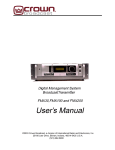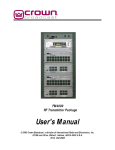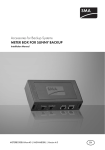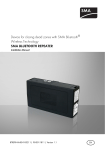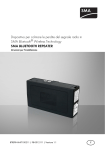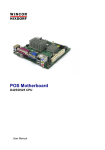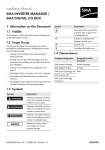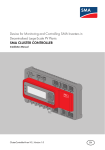Download Crown FMX30 User`s manual
Transcript
Remote Management System For FMX Transmitters User’s Manual ©2002 Crown Broadcast, a division of International Radio and Electronics, Inc. 25166 Leer Drive, Elkhart, Indiana, 46514-5425 U.S.A. (574) 262-8900 Revision Control Revision Print Date Revision 2.0 March 2005 Important Notices ©2002 International Radio and Electronics, Inc. All rights reserved. No part of this publication may be reproduced, transmitted, transcribed, stored in a retrieval system, or translated into any language in any form by any means without the written permission of IREC, Inc. Printed in U.S.A. IREC attempts to provide information that is accurate, complete, and useful. Should you find inadequacies in the text, please send your comments to the following address: International Radio and Electronics 25166 Leer Drive, P.O. Box 2000 Elkhart, Indiana, 46515-2000 U.S.A. ii RMS User’s Manual Revision 2.0 Table of Contents Section 1—Getting Acquainted 1.1 Description ..................................................................................................1-2 1.2 Specifications ..............................................................................................1-3 1.3 Safety Considerations ..................................................................................1-4 1.3.1 Dangers...................................................................................................1-4 1.3.2 Warnings.................................................................................................1-4 1.3.3 Cautions ..................................................................................................1-4 Section 2—Installation 2.1 Before You Install ........................................................................................2-2 2.1.1 System Connections................................................................................2-2 2.1.2 Controls and Indicators ...........................................................................2-3 2.1.3 Auxiliary Equipment Connections............................................................2-4 2.2 Installing the RMS .......................................................................................2-5 2.2.1 Installing RMS module on FMX30 transmitter ........................................2-5 2.2.2 Installing RMS module on FMX100 and FMX250 transmitters................2-7 2.3 Place into Service ........................................................................................2-8 Section 3—Operation 3.1 Introduction .................................................................................................3-2 3.2 Call In System Monitoring ...........................................................................3-2 3.3 Automatic Call out .......................................................................................3-4 3.4 Remote Control Commands ........................................................................3-5 3.4.1 Remote Power and Frequency Commands..............................................3-5 3.4.2 FMX/RMS Audio Monitoring ...................................................................3-6 3.4.3 Relay Commands ....................................................................................3-7 Section 4—Service and Support 4.1 Service.........................................................................................................4-2 4.2 24–Hour Support.........................................................................................4-2 4.3 Spare Parts..................................................................................................4-2 Appendix A—Pin Assignment Worksheet A.1 A.2 A.3 A.4 DC power supply .........................................................................................A-1 Digital status inputs.....................................................................................A-2 Analog status input......................................................................................A-3 Relay contacts .............................................................................................A-4 iii Revision 2.0 iv RMS User’s Manual Revision 2.0 I INFORMATION Section 1—Getting Acquainted This section provides a general description of the Crown Broadcast Remote Management System and introduces you to safety conventions used within this document. Review this material before installing or operating the equipment Getting Acquainted 1—1 I Revision 2.0 1.1 Description The Crown Broadcast Remote Management System (RMS) is an option for the Crown Broadcast Digital Management system found on FMX series transmitters. It adds telephone access to your transmitter without the use of a computer, modem or special software. Features include remote performance monitoring and operation of not only the transmitter but also site functions such as HVAC and tower lighting. The RMS requires only a telephone with a standard tone keypad. Commands are sent from the keypad and responses are generated by a plain language speech processor. Preset limits trigger the RMS to automatically dial control operators to alert them to problems. Illustration 1-1 RMS Mounted on back of transmitter The RMS has a battery back-up option in the event of a power failure to allow it to call the specified phone numbers and inform the user that there has been a power failure. The battery is not provided with the unit, but it has a built-in 3 stage charger to prevent any long term overcharging of the battery that is connected to it. It uses a standard 12 volt battery. 1—2 RMS User’s Manual Revision 2.0 1.2 Specifications System Compatibility Crown FMX30, FMX100 and FMX250 series transmitters. Telephone Access Dial-up telephone line by dual-tone, multifrequency keypad. AC Power 120-240 Volts AC from external power supply, 50-60 Hz Backup Battery +12 volts DC from user supplied battery. RMS maintains battery charge. Digital Status Input Eight digital inputs to monitor external equipment status. +5 Volt d.c. = High state 0 Volt d.c. = Low state Analog Status Input Four analog inputs to monitor external equipment status. -12 to +12 Volt DC Relay Output Four sets of SPDT relay contacts Current limited to 500 mA at 100 volts DC Auxiliary Power Output 5 volts DC, current limited to 500 mA Getting Acquainted 1—3 I Revision 2.0 1.3 Safety Considerations Crown Broadcast assumes the responsibility for providing you a safe product and safety guidelines during its use. “Safety” means protection to all individuals who install, operate, and service the RMS module as well as protection of the RMS module itself. To promote safety, we use standard hazard alert labeling on the product and in this manual. Follow the associated guidelines to avoid potential hazard. 1.3.1 Dangers DANGER represents the most severe hazard alert. Extreme bodily harm or death will occur if DANGER guidelines are not followed. 1.3.2 Warnings WARNING represents hazards which could result in severe injury or death. 1.3.3 Cautions CAUTION indicates potential personal injury, or equipment or property damage if the associated guidelines are not followed. Particular cautions in this text also indicate unauthorized radio-frequency operation. Pictorial or written description of hazard DANGER Severity of hazard Sever shock hazard! Turn power off and wait approximately 1 minute for capacitors to discharge before handling them. Explanation of hazard Illustration 1–2 Hazard Warning 1—4 RMS User’s Manual fi Section 2—Installation This section provides important guidelines for installing your Remote Management System. Review this information carefully for proper installation. Installation 2—1 Revision 2.0 2.1 Before You Install Before you begin installing the RMS, take time to review the following connector information: • Section 2.1.1, System Connections • Section 2.1.2, Controls and Indicators • Section 2.1.3, Auxiliary Equipment Connections 2.1.1 System Connections System connections are required connections for RMS operation. Telephone Connections Transmitter Remote I/O Power Connector System Ground Audio Monitor Illustration 2-1 RMS Controls and Connectors Telephone Connections Standard RJ-11 telephone connection. Connect to dial-up telephone line. Use one jack for the line and the other jack for monitoring the line. The jacks are wired in parallel and not switched. Transmitter Remote I/O Connections to transmitter Remote I/O connector. Power Connector Connect to AC supply and optional battery Audio Monitor A pass through connection to monitor an audio source. System Ground Connect to station system ground. 2—2 RMS User’s Manual Revision 2.0 2.1.2 Controls and Indicators Analog Gain Status Indicators Illustration 2-2 RMS Controls and Connectors Analog Gain Use to trim the analog input. Status Indicators A display of conditions and states of the RMS. A Heartbeat The RMS processor is functioning normally. The heartbeat LED will flash about once per second. B Call-out state When illuminated, the RMS is placing a call C Call-in state When illuminated, the RMS is in the call-in state D Traffic The RMS is processing a remote command. Installation 2—3 Revision 2.0 2.1.3 Auxiliary Equipment Connections Connections between the RMS and auxiliary equipment are made at a row of removable connector blocks. DC Out Digital Status Inputs Analog Status Inputs Relay Contacts Position 1-4 Position 5-20 Position 21-28 Position 29-40 Illustration 2-3 RMS Controls and Connectors DC Out A DC power supply for auxiliary relays. Output is +5 volts DC and current limited by an internal circuit breaker. Digital Status Inputs Eight digit status input to monitor external equipment. Input level is 0 to +5 volts DC. Current limited by internal circuit breaker. See Section A.2, Digital status inputs, for connector assignments an command channels. Analog Status Inputs Four analog inputs. Input range is -12 to +12 volts. Current limited by internal circuit breaker. See Section A.3, Analog status input, for connector assignments and command channels. Relay Contacts Four sets of SPDT relay contacts. Maximum voltage is 200 volts DC and current limited by internal circuit breaker. See Section A.4, Relay contacts, for connector assignments and command channels. Warning If you switch or control high voltage with the relay contacts, use wiring with appropriate insulation. Avoid contact with wiring on connector contacts. 2—4 RMS User’s Manual Revision 2.0 2.2 Installing the RMS Installation procedures vary with the model on which you are installing the RMS. Choose the appropriate procedure. FMX30 The RMS mounts directly to the back of the transmitter. FMX100 and FMX250 The RMS mounts to an additional adaptor bracket. 2.2.1 Installing RMS module on FMX30 transmitter Follow the transmitter shut down procedures. Note the position of cables before disconnecting cables on the back of the transmitter and remove the transmitter from the operating location. 1. Remove power amplifier access cover and hole plug. Power amplifier access cover Hole plug Illustration 2-4 2. Position RMS mounting bracket over the four holes with captive nuts. (Two of the holes attached the power amplifier access cover. Fasten with machine screws and lock washers. Mounting screws Mounting bracket Illustration 2-5 FMX30 with bracket installed Installation 2—5 Revision 2.0 3. Position RMS module inside the mounting bracket. Replace end screws and washers. Module Mounting bracket Machine screws Illustration 2-6 RMS module in mounting bracket 4. 2—6 Continue in Section 2.3, Place into Service. RMS User’s Manual Revision 2.0 2.2.2 Installing RMS module on FMX100 and FMX250 transmitters Follow the transmitter shut down procedures. Note the position of cables before disconnecting cables on the back of the transmitter and remove the transmitter from the operating location. FMX250G is modified the same way. 1. Loosen the power amplifier mounting screws on the back of the transmitter. Power amplifier mounting screws Illustration 2-7 Power amplifier mounting screws 2. Slide the RMS adaptor bracket between the power amplifier and transmitter body. Adaptor bracket Power amplifier Illustration 2-8 Installing FMX100 and FMX250 adaptor bracket (transmitter shown upside down) 3. Tighten power amplifier mounting screws. Installation 2—7 Revision 2.0 4. Position RMS mounting bracket over the four studs on the adaptor bracket. Fasten with nuts and lock washers. 5. Fasten RMS module onto module bracket with machine screws from installation kit. Module Machine screws Adaptor bracket Illustration 2-9 RMS mounted on the back of FMX100 2.3 1. 2. 3. 4. 5. 6. 7. 2—8 Place into Service Return the transmitter to the operating location and connect RF and AC power. Connect remote cable between the Remote I/O connector on the transmitter and the Remote I/O connector on the back of the RMS. Connect power supply cable to power supply connector. Plug external supply into AC power. Connect audio to the pass through audio connectors. See Section 3.4.2, FMX/RMS Audio Monitoring, for additional information. Connect status inputs to equipment you choose to monitor and control. The connectors for the status outputs are removable for easy connection. Use worksheets in Appendix A—Pin Assignment Worksheet. Follow instructions in transmitter manual for start up instructions. RMS User’s Manual Section 3—Operation This section provides general operating parameters of your Remote Management System and a detailed description of its operating functions Operation 3—1 Revision 2.0 3.1 Introduction The RMS operates in three remote modes. Each mode is described in the following sections. • Section 3.2, Call In System Monitoring • Section 3.3, Automatic Call out • Section 3.4, Remote Control Commands 3.2 Call In System Monitoring The RMS can monitor all system parameters with a standard telephone equipped with a tone keypad. Once connected to the RMS you can access the following information: • All readings available from the transmitter front panel, • Readings from the RMS analog inputs • Status of all RMS digital inputs. To to use call-in system monitoring: 1. Call the RMS and wait for the voice prompt or wait until the call-out message is complete. 2. Press * on the telephone keypad. 3. Choose commands from Table 3-1. Commands Description 0 * Channel #0, PA Volts 1 * Channel #1, PA Current 2 * Channel #2, RF Power 3 * Channel #3, SWR 4 * Channel #4, Temperature Deg C 5 * Channel #5, PwrSupply Volts 6 * Channel #6, ALC Level% 7 * Channel #7, Analog In 1 Volts 8 * Channel #8, Analog In 2 Volts 9 * Channel #9, Analog In 3 Volts 1 0 * Channel #10, Analog In 4 Volts Table 3-1 Remote Monitor Commands 3—2 RMS User’s Manual Revision 2.0 Commands Description 1 1 * Channel #11, Digital In 1 Hi/Lo 1 2 * Channel #12, Digital In 2 Hi/Lo 1 3 * Channel #13, Digital In 3 Hi/Lo 1 4 * Channel #14, Digital In 4 Hi/Lo 1 5 * Channel #15, Digital In 5 Hi/Lo 1 6 * Channel #16, Digital In 6 Hi/Lo 1 7 * Channel #17, Digital In 7 Hi/Lo 1 8 * Channel #18, Digital In 8 Hi/Lo 1 9 * Channel #19, Rx Signal Level TBD 2 0 * Channel #20, AC Power Status, # Go to Remote Control Functions After 30 seconds of inactivity the RMS will hang-up. Table 3-1 Remote Monitor Commands (Continued) Operation 3—3 Revision 2.0 3.3 Automatic Call out You may program the RMS to call a telephone number and give you an alarm report when triggered by preset conditions. The alarm conditions are programmed from the front panel of the FMX transmitter. Alarms include: • • • • • High VSWR Low or loss of RF power High power amplifier current, High power amplifier temperature External digital status inputs which have been set to alarm at either a high or low state • Analog inputs which have either a high or low limit alarm. If any of the alarm conditions trigger the RMS, it automatically calls the pre programmed number and gives the following voice report: • The greeting “Hello” • ID number of the RMS • A description of the alarm Once the alarm report is complete, use the remote control commands or call-in monitoring commands to correct the condition that caused the alarm. 3—4 RMS User’s Manual Revision 2.0 3.4 Remote Control Commands Use the RMS remote control commands to access the FMX transmitter settings menus as well as the external relays on the back of the RMS unit. The remote commands are password protected to allow only authorized users access. To enter the remote control commands: 1. Call the unit and wait for the voice prompt. 2. Press # and then enter the password. The RMS unit will wait for the password before proceeding. 3. Use the commands from the following sections to change setting in the transmitter. • Table 3-2, Remote Power and Frequency Commands • Table 3-3, Audio Monitoring Commands • Table 3-4, Remote Relay Control 3.4.1 Remote Power and Frequency Commands Commands in Table 3-2 list commands to change power and frequency settings. Note: Because of response time, wait several seconds after each Raise RF Power or Lower RF Power command. Commands Description 1 Raise RF Power Level 2 Lower RF Power Level 3 Turn RF Carrier ON 4 Turn RF Carrier OFF 6 RF Carrier Frequency Setting, MHz. # Hang-up After 30 seconds of inactivity, the RMS hangs up. Table 3-2 Remote Power and Frequency Commands Operation 3—5 Revision 2.0 3.4.2 FMX/RMS Audio Monitoring The RMS unit can monitor a variety of audio sources available from the FMX DMS as well as the RMS unit. Audio monitoring points include: • The demodulated left or right channel from the 'on-air' tuner that is built into the FMX transmitter. • The left or right channel audio at the XLR inputs on the back of transmitter. • The left or right channel audio output of the audio Processor/stereo generator boards. • The left or right channel audio of the external loop audio on the back of the RMS module. Use audio monitoring to troubleshoot audio problems over the telephone. It is also a quick check to verify that the transmitter is producing RF power because the antenna for the tuner is located near the RF low pass filter. 7 Audio Monitor Function 1 RMS External L + R * 2 FMX/DMS Right Input * 3 4 5 Return to Selection FMX/DMS Left Processor * 6 Return to Selection FMX/DMS Composite Audio * 7 Return to Selection FMX/DMS Right Receiver * 8 Return to Selection FMX/DMS Left Receiver * 3—6 Return to Selection FMX/DMS Right Processor * # Return to Selection FMX/DMS Left Input * # Return to Selection Return to Selection Return to Remote Control State Hang up RMS User’s Manual Revision 2.0 3.4.3 Relay Commands The following commands control the settings of the relay contacts on the back of the RMS. 5 Output Relay Control 1 Relay 1 Control * Turn Relay 1 ON # Turn Relay 1 OFF 2 Relay 2 Control * Turn Relay 2 ON # Turn Relay 2 OFF 3 Relay 3 Control * Turn Relay 3 ON # Turn Relay 3 OFF 4 # # Relay 4 Control * Turn Relay 4 ON # Turn Relay 4 OFF Return to Remote Control State Hang-up Table 3-4 Remote Relay Control Operation 3—7 Revision 2.0 3—8 RMS User’s Manual Revision 2.0 Section 4—Service and Support We understand that you may need various levels of support or that the product could require servicing at some point in time. This section provides information for both of these scenarios. Service and Support 4—1 Revision 2.0 4.1 Service The product warranty (see opposite page) outlines our responsibility for defective products. Before returning a product for repair or replacement (our choice), call our Customer Service department using the following telephone number: (866) 262-8917 Our Customer Service Representative will give you further instructions regarding the return of your product. Use the original shipping carton or a new one obtained from Crown. Place shipping spacers between the slide-out power amplifier assembly and the back panel. Please fill out the Factory Service Instructions sheet (page 7–5) and include it with your returned product. 4.2 24–Hour Support In most instances, what you need to know about your product can be found in this manual. There are times when you may need more in-depth information or even emergency-type information. We provide 24–hour technical assistance on your product via a toll telephone call. For emergency help or detailed technical assistance, call (866) 262-8917 You may be required to leave a message at this number but your call will be returned promptly from our on-call technician. 4.3 Spare Parts To obtain spare parts, call Crown Broadcast Sales at the following number. (866) 262-8917 You may also write to the following address: Service Manager International Radio and Electronics Company, Inc. 25166 Leer Drive Elkhart, Indiana, U.S.A. 46514-5425 4—2 RMS User’s Manual Revision 2.0 Three-Year Limited Warranty North America Only SUMMARY OF WARRANTY We, Crown Broadcast, a business unit of International Radio and Electronics Company, Inc., 25166 Leer Drive, Elkhart, Indiana 46515–2000 warrant to the ORIGINAL PURCHASER of a NEW Crown Broadcast product, for a period of three (3) years from the date of purchase by the original purchaser (the “warranty period”) that the new Crown Broadcast product is free of defects in materials and workmanship and will meet or exceed all advertised specifications for such a product. This warranty does not extend to any subsequent purchaser or user, and automatically terminates upon sale or other disposition of our product. ITEMS EXCLUDED FROM THIS CROWN BROADCAST We are not responsible for product failure caused by misuse, accident, or neglect. This warranty does not extend to any product on which the serial number has been defaced, altered, or removed. It does not cover damage to loads or any other products or accessories resulting from Crown Broadcast product failure. It does not cover defects or damage caused by use of unauthorized modifications, accessories, parts, or service. WHAT WE WILL DO We will remedy any defect, in material or workmanship (except as excluded), in our sole discretion, by repair, replacement, or refund. If a refund is elected, then you must make the defective or malfunctioning component available to us free and clear of all liens or other encumbrances. The refund will be equal to the actual purchase price, not including interest, insurance, closing costs, and other finance charges less a reasonable depreciation on the product from the date of original purchase. Warranty work can only be performed at our authorized service centers or at our factory. Expenses in remedying the defect will be borne by Crown Broadcast, including two-way surface freight shipping costs within the United States. (Purchaser must bear the expense of shipping the product between any foreign country and the port of entry in the United States and all taxes, duties, and other custom’s fee(s) for such foreign shipments.) HOW TO OBTAIN WARRANTY SERVICE You must notify us of your need for warranty service not later than ninety (90) days after the expiration of the warranty period. We will give you an authorization to return the product for service. All components must be shipped in a factory pack or equivalent which, if needed, may be obtained from us for a nominal charge. Corrective actions will be taken within a reasonable time of the date of receipt of the defective product by us. If the repairs made by us are not satisfactory, notify us immediately. DISCLAIMER OF CONSEQUENTIAL AND INCIDENTAL DAMAGES You are not entitled to recover from us any consequential or incidental damages resulting from any defect in our product. This includes any damage to another product or products resulting from such a defect. WARRANTY ALTERATIONS No person has the authority to enlarge, amend, or modify this warranty. The warranty is not extended by the length of time for which you are deprived of the use of the product. Repairs and replacement parts are provided under the terms of this warranty shall carry only the unexpired portion of this warranty. DESIGN CHANGES We reserve the right to change the design of any product from time to time without notice and with no obligation to make corresponding changes in products previously manufactured. LEGAL REMEDIES OF PURCHASER There is no warranty which extends beyond the terms hereof. This written warranty is given in lieu of any oral or implied warranties not contained herein. We disclaim all implied warranties, including without limitation any warranties of merchantability or fitness for a particular purpose. No action to enforce this warranty shall be commenced later than ninety (90) days after expiration of the warranty period. Crown Broadcast, International and Radio Company, Inc. 25166 Leer Drive, P.O. Box 2000, Elkhart, Indiana 46515–2000 Phone: (574) 262-8900; FAX: (574) 262-5399 Service and Support 4—3 Revision 2.0 Factory Service Instructions To obtain factory service, complete the bottom half of this page, include it with the unit, and ship to: International Radio and Electronics Company, Inc. 25166 Leer Drive Elkhart, Indiana, U.S.A. 46514-5425 For units in warranty (within 3 years of purchase from any authorized Crown Dealer): We pay for ground UPS shipments from anywhere in the continental U.S. and Federal Express Second Day service from Hawaii and Alaska to the factory and back to you. Expedited service/shipment is available for an additional charge. You may ship freight collect (COD for cost of freight) or forward your receipt for shipping charges which we will reimburse. We do not cover any charges for shipping outside the U.S. or any of the expenses involved in clearing customs. If you have any questions about your Crown Broadcast product, please contact Crown Broadcast Customer Service at: Telephone: (574) 262-8900 Fax: (574) 262-5399 Name: Company: Shipping Address: Phone Number: Model: Fax: Serial Number: Purchase Date: Nature of the Problem: Describe the conditions that existed when the problem occurred and what attempts were made to correct it. Other equipment in your system: If warranty has expired, payment will be: Cash/Check VISA Mastercard Please Quote before servicing Card Number: Exp. Date: COD Signature: Return shipment preference if other than UPS Ground: Expedite Shipment Other ENCLOSE WITH UNIT—DO NOT MAIL SEPARATELY 4—4 RMS User’s Manual Revision 2.0 Appendix A—Pin Assignment Worksheet The following worksheets provide both the pin descriptions, RMS commands and an area to record connections to each pin. A.1 DC power supply Use the 5 volt DC supply to power auxiliary relays or other external equipment. See Section 1.2, Specifications, for supply limitations. Pin Signal Connected to 1 +5 Volt DC supply 2 +5 Volt DC supply 3 Supply ground 4 Supply ground Table A-1 DC power supply A-1 Revision 2.0 A.2 Digital status inputs Use the digital status inputs to monitor signals which can be represented as either an on or off condition. Input level is 0 to +5 volts DC. Digital status inputs are optically isolated digital inputs which can be monitored by selecting a status channel indicated in Table A-2, Digital Status Input. See Section 1.2, Specifications, for current and voltagespecifications. Pin Digital Status Input 5 1 + 6 1 - 7 2 + Monitor on Status Channel Connected to 11 12 8 2 - 9 3 + 10 3 - 11 4 + 13 14 12 4 - 13 5 + 14 5 - 15 6 + 15 16 16 6 - 17 7 + 18 7 - 19 8 + 17 18 20 8 Table A-2 Digital Status Input A-2 RMS User’s Manual Revision 2.0 A.3 Analog status input Use the analog status inputs to monitor a signal which can be converted to a range of 0 to 12 volts DC. Use the following formula to convert the input votage to the voltage monitored. Monitored voltage = Input voltage(5/12) Analogital status inputs are can be monitored by selecting a status channel indicated in the following table. See Section 1.2, Specifications, for input current and voltage specifications. Pin Analog Status Input 21 1 + 22 1 - 23 2 + 24 2 - 24 3 + 26 3 - 27 4 + 28 4 - Monitor Status on Channel Connected to 7 8 9 10 Table A-3 Analog Status Inputs A-3 Revision 2.0 A.4 Relay contacts Use relay contacts to control auxilary equipment. See Section 1.2, Specifications, for relay contact specifications. Warning If you switch or control high voltage with the relay contacts, use wiring with appropriate insulation. Avoid contact with wiring on connector contacts. Pin Relay Contact 29 1 Common 30 1 Normally Closed 31 1 Normally Open 32 2 Common 33 2 Normally Closed 34 2 Normally Open 35 3 Common 36 3 Normally Closed 37 3 Normally Open 38 4 Common 39 4 Normally Closed 40 4 Normally Open Control on Channel Connected to 5,1 5,2 5,3 5,4 Table A-4 Relay Contacts A-4 RMS User’s Manual

































